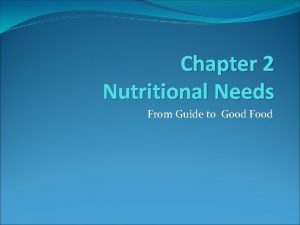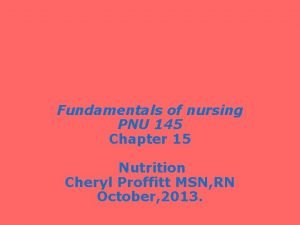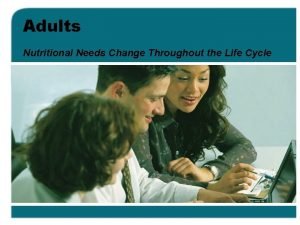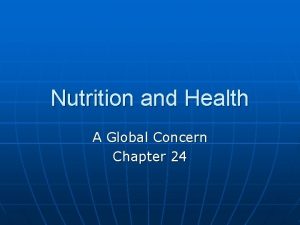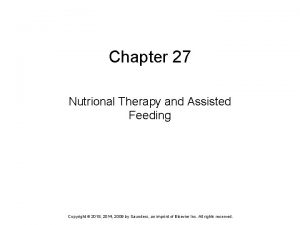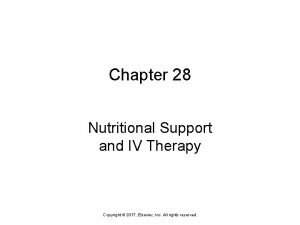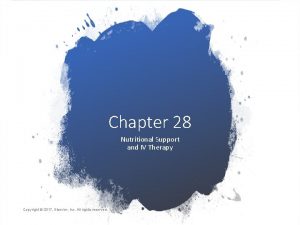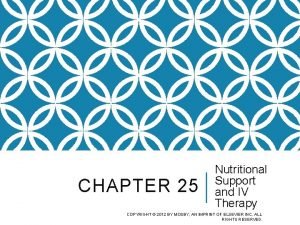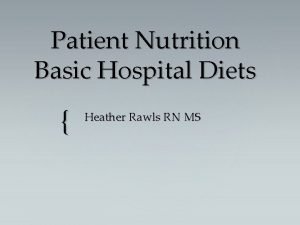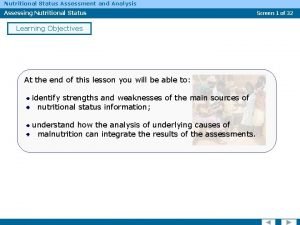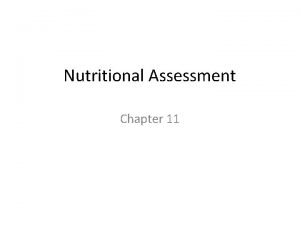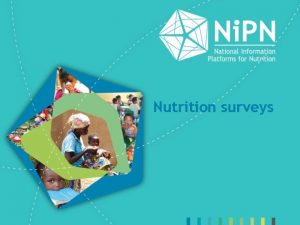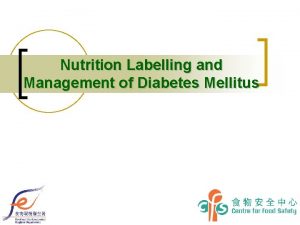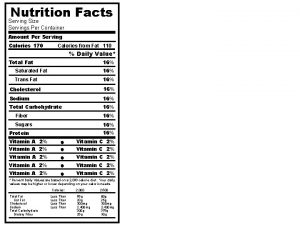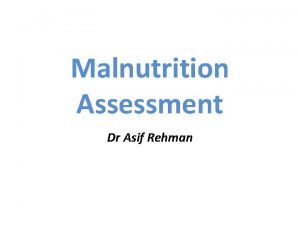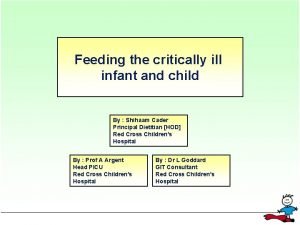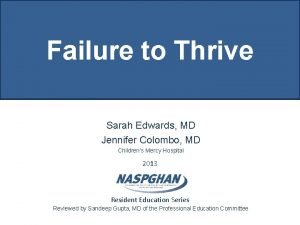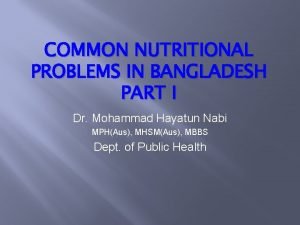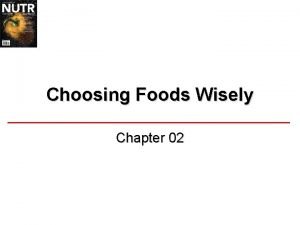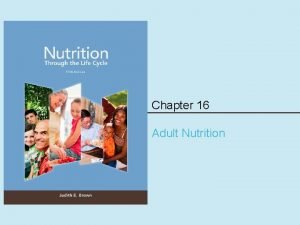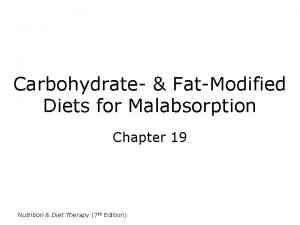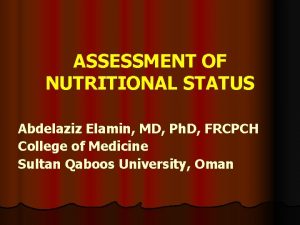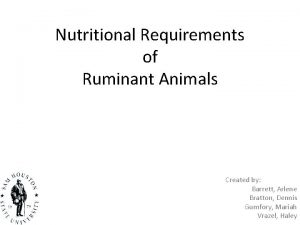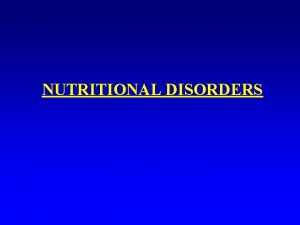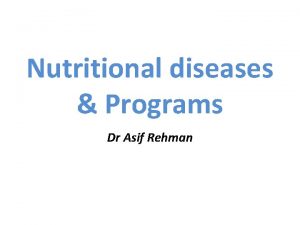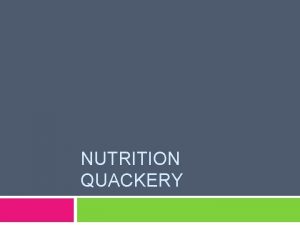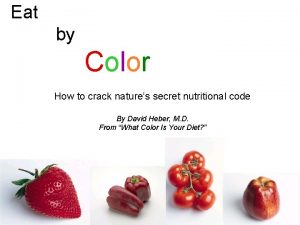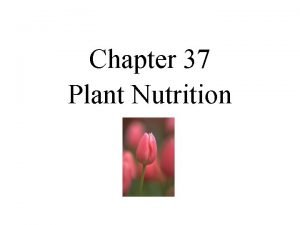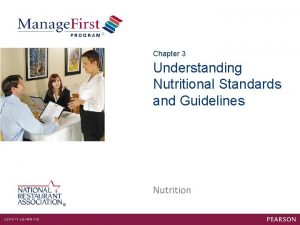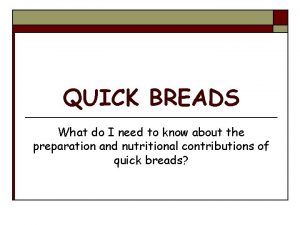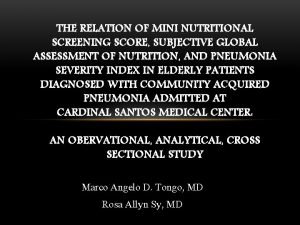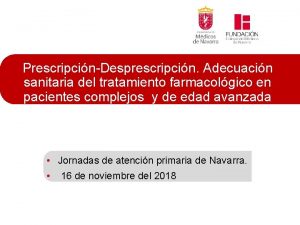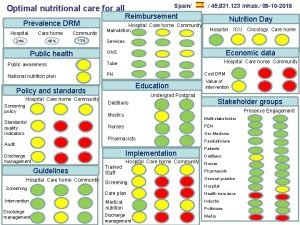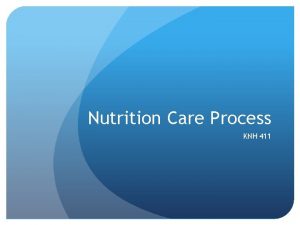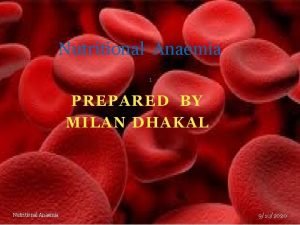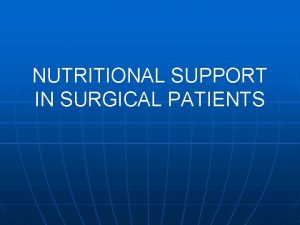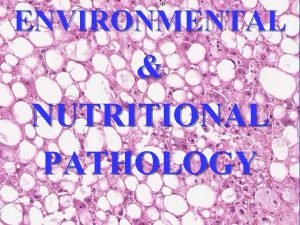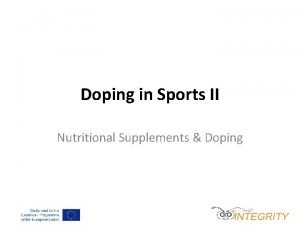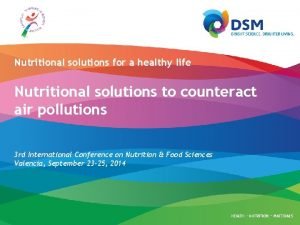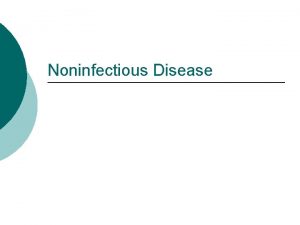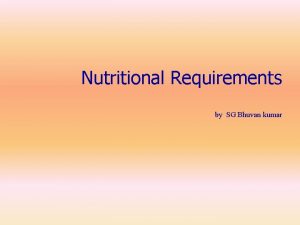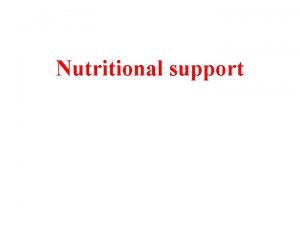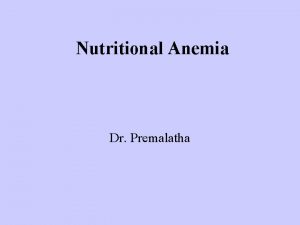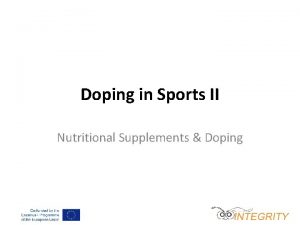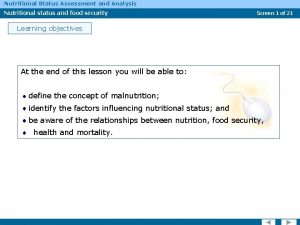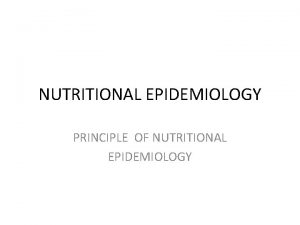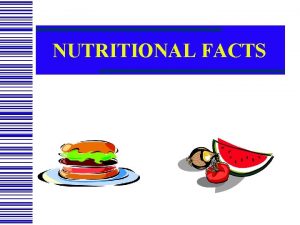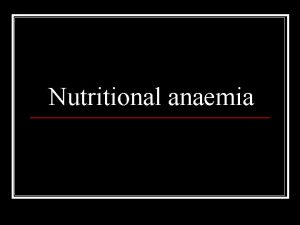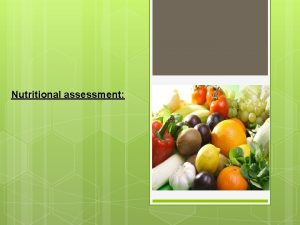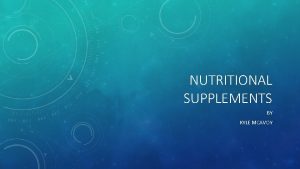Chapter 2 Nutritional Needs From Guide to Good



















































- Slides: 51

Chapter 2 Nutritional Needs From Guide to Good Food

Nutritional Needs The foods you eat affect your state of health. Nutrients are chemical substances that help maintain the body. Nutrition is the study of how your body uses the nutrients in the foods you eat. If you do not eat the foods your body needs you may suffer from malnutrition which is a lack of the right proportions of nutrients over a extended period.

The Nutrients You need of 50 nutrients for good health. Some provide energy, while others help build and maintain cells and tissue. There is no one single food that provides all the nutrients for your body to function properly. They are broken down in 6 major groups.

The Nutrients Failure to meet your nutrient needs may result in a deficiency disease. This is a illness caused by the lack of a sufficient amount of a nutrient. In order to meet the nutrient needs, some people use dietary supplements. These are purified nutrients that are manufactured or extracted from natural sources.

The Nutrients Supplements usually come in tablet, capsule, liquid or powder form. They can provide a single nutrient or multiple nutrient. Supplements are neither food or drugs so they are not regulated by the FDA.

The Nutrients Not all dietary supplements provide nutrients. Some provide no nutrient substances. Ex. Photochemical substances. These are believed to help prevent cancer and heart disease. A other source is fortified foods. These are simply foods that have been altered to carry more of what would occur naturally in the food.

Carbohydrates These are the body's chief source of energy. Most come from plant food. Three majors are sugar, starches, and fiber. Because of their molecular structure sugars are called simple carbohydrates.

Carbohydrates The diet includes 6 types of sugars. Three or single sugar units. 1. Glucose is the form of sugar carried through the blood stream for energy use through out the body. 2. Fructose, which is also know as fruit sugar is the sweetest of all. 3. Galactose, it is found attached to glucose to form the sugar in milk.

Carbohydrates The next three are a pair of sugars 1. Sucrose, ordinary table sugar. 2. Lactose, sugar found in the milk of mammals 3. Maltose, which is grain sugar or malt sugar. Starches and fibers are often called complex carbs, because they are made from many glucose sugar units that are bonded together.

Carbohydrates Starch is the storage form of energy in plants. Because humans eat an array of plant food, starch is the most abundant carbohydrate in the body. When digested they release the energy plants have stored as starch, which we can use the released energy as fuel.

Carbohydrates Fiber is a form of complex carbs from plants that humans cannot digest. Therefore it dose not provide the body with energy like other carbs, however it dose provide bulk in the diet and causes normal bowel movements.

Functions of Carbohydrates The main function is to provide the body with energy. The only source of energy that the brain can use. Can be used by the body as a energy source more readily than protein or fats. Functions performed by fiber are linked to the prevention of heart disease and some types of cancer.

Carbohydrates Fiber binds to a compound found in cholesterol and carries it out of the body. This helps lower body cholesterol levels, which reduces the risk of heart disease. Fiber also helps seed up the digestive system and the bulk helps in diluting carcinogens. Recommended men through 50 eat 38 grams and women 25 grams a day.

Sources of Carbohydrates Many foods are a rich source of carbohydrates. Foods high in simple carbs include sugars, syrups, soft drinks, jams, jellies, candies, and other sweeteners. Sources of starch are bread, cereals, pasta, and rice. Some veg. such as potatoes, corn, and dry beans and peas are high in starch. Whole grain cereal products and fresh fruits and vegetables are a good source of fiber.

Carbohydrate Deficiencies and Excesses Foods high in carbs are abounded and inexpensive. Because of this deficiencies are usually the result of self prescribed limitations. A diet low in carbs may cause the body to use protein as energy.

Carbohydrate Deficiencies and Excesses This can interfere with proper growth and repair of body tissue. This can also cause a chemical imbalance that can be dangerous if it is allowed to continue. If fiber is lacking constipation can occur.

Carbohydrate Deficiencies and Excesses Food energy is measured in calories. Nutritionist recommended that most of your calories come from complex carbs that are high in fiber. They also recommend limited the amount consumed from fat. Eating a diet high in whole grain breads and cereals will accomplish both.

Carbohydrate Deficiencies and Excesses Too many simple carbs in a diet can be a health concern. This can increase the chances of unhealthful weight gain. Bacteria in the mouth react with sugar and starch to form a acid that can erode teeth and cause tooth decay and gum disease. So brush after eating is recommended.

Fats are a important energy source. They belong to a larger group called lipids that include both fats and oils. All lipids contain fatty acids. A fatty acid is a chemical chain that contains carbon, hydrogen, and oxygen atoms.

Fats are a important energy source. They belong to a larger group called lipids that contain both fats and oils. All lipids contain fatty acids. A fatty acids are chemicals that contain carbon, hydrogen, and oxygen atoms.

Fats Saturated contain as many hydrogen atoms as they can hold Unsaturated have fewer hydrogen atoms than they can hold. Unsaturated fatty acids can be monounsaturated or polyunsaturated.

Fats Monounsaturated- are missing only one hydrogen atom. Polyunsaturated are missing two or more. Fats and Oils in foods contain a mixture of the three types of Fatty Acids. Learning which foods contain more of each type will help you in eating healthier.

Fats that are high in saturated fats are solid at room temperature. Most oils that are high in unsaturated fatty acids are liquid at room temperature. A process called hydrogenation adds hydrogen atoms to unsaturated fatty acids in liquid oils. This turns the oils into more highly saturated fats.

Fats Hydrogenation creates trans fatty acids, or trans fat. These are fats with weird molecular shapes. Most shortening and stick margarine are made from hydrogenated oils. Because of this these foods, and baked goods made with them, contain trans fat. Trans fat also occurs naturally in dairy products, beef, and lamb

Cholesterol is a fatlike substance found in every cell of the body. Serves several important functions. 1. PART OF SKIN TISSUE 2. AIDS IN TRANSPORTATION OF FATTY ACIDS IN THE BODY 3. ALSO NEEDED FOR THE BODY TO PRODUCE HARMONES

Cholesterol You need to beware that health and nutrition experts refer to two types pf cholesterol. 1. Dietary cholesterol you consume when you eat certain foods of only animal origin. Liver & Egg Yolks are high in this. 2. Blood cholesterol circulates through your blood stream. A high blood cholesterol is a risk factor of heart disease. Your diet has only a small effect on your blood cholesterol.

Functions of Fats They provide a source of energy. They carry certain vitamins. They carry flavor substances that make food taste good. They can make food more tender. They also help make you feel full after eating.

Functions of Fats Your body needs various fatty acids to make hormones. Your body produces some FA that you need, however there a few that it cannot. These are called essential fatty acids. You obtain them from the foods you eat.

Functions of Fats They body stores energy in fat tissue. Besides energy stores these tissues serve as a cushion for you internal organs and as insulation to keep you warm.

Sources of Fats Saturated fast are found in dairy and meat products. This is why health experts recommend eating low fat or fat free products. You should get a majority of your fat from Mono & Poly unsaturated fats. Fish, nuts, and veg. oils are rich in these. Olives and avocados are high in these.

Fat Deficiencies Fat deficiencies are rare in the united states. A diet to low in fat can cause in weight loss and energy. Also may cause deficiencies of the fatty acids and fat soluble vitamins carried by fats.

Proteins are chemical compounds that are found in every body cell. They are made up of small units called amino acids. They are 20 amino acids that are important to the body, of that 9 are essential. Must get these from foods we eat. The other 11 are non essential. Our bodies can make these without the assistance of food.

Proteins Animal foods and soybeans have complete proteins. These contain all the essentials. Incomplete proteins can complement each other. They do not have to be eaten together, as long as they are consumed through out the day. Ex Dry beans & grains.

Functions of proteins Your body needs amino acids from protein for growth, maintenance, and repair of tissue. Aid in formation of enzymes, some horomones, and antibodies. They also provide energy.

Functions of protein If you do not consume enough carbs or fats your body will use protein as fuel before it is used for growth or repair. Protein needs are based mostly on age, body style, and physical activity. Children, pregnant women, and nursing women need more than regular adults.

Source of protein Complete proteins are lean meats, poultry, fish, milk, cheese, and eggs. Incomplete are found in dry beans, peas, and nuts. Grains and vegetable provide a small amount of incomplete proteins.

Protein Deficiencies and Excesses If a diet dosenot contain enough protein and calories, a condition called protein-energy malnutrition may result. If you take to much protein your body will store it as fat and stores it in fat tissue. Your body cannot reconvert stored protein back to amino acids.

Vitamins are a complex organic substance. You need them in small amounts for normal growth, maintenance, and reproduction. Your body cannot produce most vitamins, at least not in the amount to meet your nutritional needs.

Vitamins The best way to get all the vitamins you need is to eat a nutritional diet. Vitamins are either fat-soluble or water soluble. Fat-soluble dissolve in fat. Stored in fat tissue. Water-soluble dissolve in water. Excess are carried out the body in urine.

Vitamin A The body uses this to help eyes adapt to darkness. Promotes growth. Found in butter, oranges, cheeses, liver, & spinach. Second form beta carotene which is a pro vitamine.

Vitamin A Deficiencies Blindness, stunted growth, rough skin, and more prone to certain diseases.

Vitamin D To promote growth and proper minerialization of bones and teeth. Occur naturally in egg yolks, fish oil, the sun. it is also added to most milk. If not enough consumed rickets can form in small children. Results in crooked legs and misshapen breast bone.

Vitamin E Mainly functions as an antioxidant. Found in fats, oil, whole grain breads, deep green vegetables. Deficiencies are rare. Only found in premature infants.

Vitamin K Known as the blood clotting vitamin. Helps liver make prothrombin. This is a protein blood needs to clot. Found in bacteria located in the intestinal tract. Leafy green veg and cauliflower. Also found in vegetables, organ meat, and egg yolks. Most people receive enough however if there is a deficiencies hemorrhage can occur due to blood not clotting.

Vitamin C It forms in the formation and maintains of collegen, makes blood vessels firm. Helps wounds heal and broken bones Found in broccoli, fruits, and veg. Strawberries Can cause poor appetite, weakness, bruises, and sourness in joints. Can cause scurvy- weakness bleeding gums, tooth loss, and internal bleeding.

Thiamin Helps promote normal appetite and digestion. Helps body release energy from food. Helps keep the nervous system healthy. Wheat germ, dry beans, eggs, and pork products. Cause nausea, apathy, loss of appetite. Results in a disease in the nervous system called beri. Which is numbness in the feet and ankles.

Riboflavin Needed for break down of carbohydrates. Helps cells use oxygen. Helps keep skin, tongue, and lips normal. Found in organ meats, milk products, eggs, and oysters. To little can cause swollen and cracked lips and skin lesions. Inflammation of the eyes and twilight blindness.

Niacin Helps keep the nervous system, mouth, skin, tong, and digestive tract healthy Muscle meats, poultry, nuts, and peanut butter. Can cause a disease called pellagra. To much causes nausea, vomiting, and red flushing of the face, chest, and arms.

Vitamin B 6 Helps nervous tissue functions and plays in the role of red blood cell regeneration. Takes part in the break down of proteins, carbs, and fats. Found in many plant and animal foods. Best source muscle meats, liver, vegetables, and whole grains. Lack of this vitamin cause skin lessons, soreness of mouth, and smooth red tongues.

Folate Is a b complex vitamin that helps the body produce normal blood cells. Very important to the diets of pregnant women and is giving usually as a supplement. Found in broccoli, asparagus, leafy green veg. and dry beans and peas. Inflammation of tongue and digestive disorders. Also can result in anemia. Which reduces number of red blood cells in the blood stream. Causes weakness and fatigue.

Vitamin b 12
 Chapter 2 nutritional needs
Chapter 2 nutritional needs Nutritional needs in fundamentals of nursing
Nutritional needs in fundamentals of nursing Nutritional needs throughout the life cycle
Nutritional needs throughout the life cycle Good thoughts good words good actions
Good thoughts good words good actions Hi good morning video
Hi good morning video Hello good afternoon teacher
Hello good afternoon teacher You are good you are good when there's nothing good in me
You are good you are good when there's nothing good in me Good morning good afternoon
Good morning good afternoon Primary needs and secondary needs
Primary needs and secondary needs Primary needs and secondary needs
Primary needs and secondary needs Primary needs and secondary needs
Primary needs and secondary needs Strategic gender needs and practical gender needs
Strategic gender needs and practical gender needs Target need analysis
Target need analysis Chapter 24 nutritional care and support
Chapter 24 nutritional care and support Chapter 27 nutritional therapy and assisted feeding
Chapter 27 nutritional therapy and assisted feeding Chapter 28 nutritional support and iv therapy
Chapter 28 nutritional support and iv therapy Chapter 28 nutritional support and iv therapy
Chapter 28 nutritional support and iv therapy Chapter 28 nutritional support and iv therapy
Chapter 28 nutritional support and iv therapy Valoarea calorica a alimentelor
Valoarea calorica a alimentelor Nutritional habits of hypnum sp
Nutritional habits of hypnum sp As nutritional energy passes through the food chain it is
As nutritional energy passes through the food chain it is Clear liquid diet foods
Clear liquid diet foods Nutritional status assessment
Nutritional status assessment Advantages and disadvantages of nutritional epidemiology
Advantages and disadvantages of nutritional epidemiology Optimal nutritional status
Optimal nutritional status Types of nutritional survey
Types of nutritional survey Nutritional management of diabetes mellitus
Nutritional management of diabetes mellitus Servings per container 30
Servings per container 30 Malnutrition conclusion
Malnutrition conclusion Major nutritional deficiency diseases in emergencies
Major nutritional deficiency diseases in emergencies Abcd of nutritional assessment
Abcd of nutritional assessment Ftt criteria
Ftt criteria Common nutritional disorder in bangladesh
Common nutritional disorder in bangladesh Abcd of nutritional assessment
Abcd of nutritional assessment Nutritional intervention
Nutritional intervention Malabsorption causes
Malabsorption causes Abcd nutrition assessment
Abcd nutrition assessment Continuous feeding vs bolus feeding
Continuous feeding vs bolus feeding Nutritional requirements for ruminant animals
Nutritional requirements for ruminant animals Nutritional diseases
Nutritional diseases Nutritional diseases
Nutritional diseases Nutritional diseases
Nutritional diseases What is nutritional quackery
What is nutritional quackery How can we crack nature’s secret nutritional code
How can we crack nature’s secret nutritional code Nutritional requirements of plants
Nutritional requirements of plants Concept of nutritional standard
Concept of nutritional standard Quick breads definition
Quick breads definition Mini nutritional assessment
Mini nutritional assessment Mini nutritional assessment short form
Mini nutritional assessment short form Optimal nutritional care for all
Optimal nutritional care for all Ada 411
Ada 411 Public health nutrition definition
Public health nutrition definition
